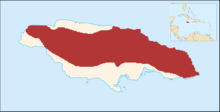Caribbean pigeon
| Caribbean pigeon | ||||||||||
|---|---|---|---|---|---|---|---|---|---|---|

Caribbean pigeon |
||||||||||
| Systematics | ||||||||||
|
||||||||||
| Scientific name | ||||||||||
| Patagioenas caribaea | ||||||||||
| ( Jacquin , 1784) |
The Caribbean pigeon ( Patagioenas caribaea ) is a species within the genus of American field pigeons . It is a large, strongly built and pale colored pigeon that is found exclusively in Jamaica. No subspecies are distinguished.
The stock situation is indicated with vu (= vulnerable - endangered).
features
Caribbean pigeons reach a body length of 38 to 48 centimeters. It weighs an average of 250 grams. The sexual dimorphism is hardly pronounced.
The males are pale mauve- pink on the forehead, crown and neck . On the back of the neck they have iridescent, delicate pink to green gold plumage parts. The mantle and the wing covers are pale gray-brown. The back, the rump and the upper tail-coverts are pale in color than these. The arm wings are of a darker shade of brown, the hand wings are black-brown with a fine isabel-colored border. Similar to the scaly- necked pigeon and the Araucanian pigeon, there is a wide black transverse band on the tail . The chin and throat are whitish, the underside of the body is pale brownish pink up to the front belly, the rear belly and the under tail-covers are whitish. The iris is orange-red to red. The orbital ring is purple-red, the beak is black. The legs and feet are red.
Females are colored similarly to the males, but overall a little more dull and brown. Young birds resemble the females, there are also rust-brown feathers on the head and on the wing covers and the wings of the hand.
In the distribution area of the pigeon there is no other species with which it can be confused. The voice of the pigeon is a soft go-uuu.
Distribution area and habitat
The pigeon is found exclusively on the island of Jamaica . There it is a resident bird that only migrates between the lowlands and the highlands in response to a fluctuating food supply. In the summer half of the year it is mainly found in higher regions.
The habitat are primary forests at altitudes between 150 and 2000 meters in the most isolated regions of the island. Their occurrence may be correlated with Nectandra antilliana , a tree in the genus Nectandra . However, it is also observed in secondary forests and occurs in clearings and agricultural areas. However, it is exposed to considerable hunting pressure, so that colonization of anthropogenically shaped landscapes is largely absent.
Way of life
Caribbean pigeons live exclusively on trees and almost never come to the ground. They eat a number of fruits, berries and seeds and, like many representatives of the American field pigeons, show a fondness for mistletoe berries .
Caribbean pigeons breed in spring and summer when they prefer to stay in the highlands of Jamaica. The nest is a loose platform made of twigs and covered with bark and leaves. The breeding biology has not been conclusively investigated. Carribean pigeons, like the closely related species, probably lay a single white or cream-colored egg.
attitude
The black pigeon was first shown at London Zoo in 1904 . The Hope Zoo in Kingston, Jamaica has had a breeding program for this species since the 1990s.
literature
- David Gibbs, Eustace Barnes and John Cox: Pigeons and Doves - A Guide to the Pigeons and Doves of the World . Pica Press, Sussex 2001, ISBN 90-74345-26-3 .
- Gerhard Rösler: The wild pigeons of the earth - free living, keeping and breeding . M. & H. Schaper Verlag, Alfeld-Hannover 1996, ISBN 3-7944-0184-0 .
Web links
- Patagioenas caribaea in the endangered Red List species the IUCN 2012. Posted by: BirdLife International, 2012. Accessed September 24, 2016th
- Voice of the pigeon on Xeno Canto
Single receipts
- ↑ a b c d e Gibbs, Barnesund Cox: Pigeons and Doves , p. 224.
- ↑ Patagioenas caribaea in the endangered Red List species the IUCN 2012. Posted by: BirdLife International, 2012. Accessed September 25, 2016th
- ^ A b Gibbs, Barnesund Cox: Pigeons and Doves , p. 225.
- ↑ Rösler: The wild pigeons of the earth - free life, keeping and breeding . P. 103.
- ^ Voice of the Caribbean Pigeon on Xeno Canto , accessed September 25, 2016
- ↑ Rösler: The wild pigeons of the earth - free life, keeping and breeding . P. 104.
- ↑ Global Species - Zoological Gardens , accessed September 27, 2016
